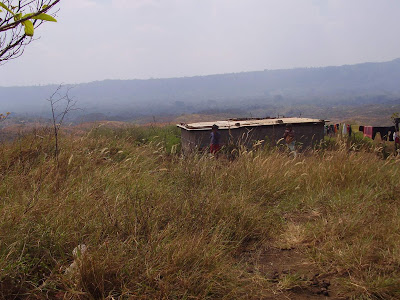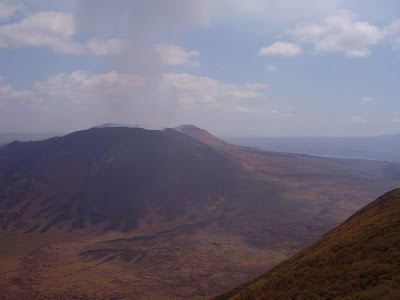I had no idea that Victor Hugo was here! Momotombo is a real miracle! It doesn't surprise me that he became a national simbol. And what beatiful poems were written about him.


 Les raisons du Momotombo
Les raisons du Momotombo« Le baptême des volcans est un ancien usage qui
remonte aux premiers temps de la conquête. Tous
les cratères du Nicaragua furent alors sanctifiés, à
l’exception du Momotombo, d’où l’on ne vit
jamais revenir les religieux qui s’étaient chargés
d’aller y planter la croix. »
Séquier : Voyage dans l’Amérique du Sud.
Trouvant les tremblements de terre trop fréquents,
Les rois d’Espagne ont fait baptiser les volcans
Du royaume qu’ils ont en dessous de la sphère ;
Les volcans n’ont rien dit et se sont laissé faire,
Et puis le Momotombo lui seul n’a pas voulu.
Plus d’un prêtre en surplis, par le saint-père élu,
Portant le sacrement que l’Eglise administre,
L’œil au ciel, a monté la montagne sinistre ;
Beaucoup y sont allés, pas un seul n’est revenu.
O vieux Momotombo, colosse chauve et nu.
Qui songe près des mers, et fais de ton cratère
Une tiare d’ombre et de flamme à la terre.
Pourquoi, lorsqu'à ton seuil terrible nous frappons,
Ne veux-tu pas du Dieu qu’on t’apporte ? Réponds.
La montagne interrompt son crachement de lave,
Et le Momotombo répond d’une voix grave :
« Je n’aimais pas beaucoup le dieu qu’on a chassé.
Cet avare cachait de l’or dans un fossé ;
Il mangeait de la chair humaine ;
ses mâchoires Etaient de pourriture et de sang toutes noires.
Son antre était un porche au farouche carreau,
Temple sépulcre orné d’un pontife bourreau ;
Des squelettes riaient sous ses pieds ;
les écuelles Où cet être buvait le meurtre étaient cruelles ;
Sourd, difforme, il avait des serpents au poignet ;
Toujours entre ses dents un cadavre saignait ;
Ce spectre noircissait le firmament sublime.
J’en grondais quelques fois au fond de mon abîme.
Aussi, quand sont venus, fiers sur les flots tremblants.
Et du côté d’où vient le jour, des hommes blancs,
Je les ai bien reçus, trouvant que c’était sage.
— L’âme a certainement la couleur du visage,
Disais-je, l’homme blanc, c’est comme le ciel bleu ;
Et le dieu de ceux-ci doit être un très bon dieu.
On ne le verra point de meurtres se repaître.
— J’étais content ; j’avais horreur de l’ancien prêtre ;
Mais quand j’ai vu comment travaille le nouveau,
Quand j’ai vu flamboyer, ciel juste ! à mon niveau !
Cette torche lugubre, âpre, jamais éteinte,
Sombre, et que vous nommez l’Inquisition sainte,
Quand j’ai pu voir comment Torquemada s’y prend
Pour dissiper la nuit du sauvage ignorant,
Comment il civilise, et de quelle manière
Le Saint-Office enseigne et fait de la lumière,
Quand j’ai vu dans Lima d’affreux géants d’osier,
Pleins d’enfants, pétiller sur un large brasier,
Et le feu dévorer la vie, et les fumées
Se tordre sur les seins des femmes allumées ;
Quand je me suis senti parfois presque étouffé
Par l’âcre odeur qui sort de votre autodafé,
Moi qui ne brûlais rien que l’ombre en ma fournaise,
J’ai pensé que j’avais eu tort d’être bien aise ;
J’ai regardé de près le dieu de l’étranger,
Et j’ai dit : — Ce n’est pas la peine de changer. »
Victor Hugo "La Légende des Siècles”

Momotombo
O vieux Momotombo, colosse chauve et nu...
V. H.
El tren iba rodando sobre sus rieles. Era
en los días de mi dorada primavera
y era en mi Nicaragua natal.
De pronto, entre las copas de los árboles, vi
un cono gigantesco, "calvo y desnudo", y
lleno de antiguo orgullo triunfal.
Ya había yo leído a Hugo y la leyenda
que Squier le enseñó. Como una vasta tienda
vi aquel coloso negro ante el sol,
maravilloso de majestad. Padre viejo
que se duplica en el armonioso espejo
de un agua perla, esmeralda, col.
Agua de un vario verde y de un gris tan cambiante,
que discernir no deja su ópalo y su diamante,
a la vasta llama tropical.
Momotombo se alzaba lírico y soberano,
yo tenía quince años: ¡una estrella en la mano!
Y era en mi Nicaragua natal.
Ya estaba yo nutrido de Oviedo y de Gomara,
y mi alma florida soñaba historia rara,
fábula, cuento, romance, amor
de conquistas, victorias de caballeros bravos,
incas y sacerdotes, prisioneros y esclavos,
plumas y oro, audacia, esplendor.
Y llegué y vi en las nubes la prestigiosa testa
de aquel cono de siglos, de aquel volcán de gesta,
que era ante mí de revelación.
Señor de las alturas, emperador del agua,
a sus pies el divino lago de Managua,
con islas todas luz y canción.
¡Momotombo! -exclamé- ¡Oh nombre de epopeya!
Con razón Hugo el grande en tu onomatopeya
ritmo escuchó que es de eternidad.
Dijérase que fuese para las sombras dique,
desde que oyera el blanco la lengua del cacique
en sus discursos de libertad.
Padre de fuego y piedra, yo te pedí ese día
tu secreto de llamas, tu arcano de armonía,
la iniciación que podías dar;
por ti pensé en lo inmenso de Osas y Peliones,
en que arriba hay titanes en las constelaciones
y abajo dentro la tierra y el mar¡
Oh Momotombo ronco y sonoro! Te amo
porque a tu evocación vienen a mí otra vez,
obedeciendo a un íntimo reclamo
perfumes de mi infancia, brisas de mi niñez.
¡Los estandartes de la tarde y de la aurora!
Nunca los vi más bellos que alzados sobre ti,
toda zafir la cúpula sonora
sobre los triunfos de oro, de esmeralda y rubí.
Cuando las babilonias del Poniente
en purpúreas catástrofes hacia la inmensidad
rodaban tras la augusta soberbia de tu fuente
eras tú como el símbolo de la Serenidad.
En tu incesante hornalla vi la perpetua guerra,
en tu roca unidades que nunca acabarán.
Sentí en tus terremotos la brama de la tierra
y la inmortalidad de Pan.
¡Con un alma volcánica entré en la dura vida,
Aquilón y huracán sufrió mi corazón
y de mi mente mueven la cimera encendida
huracán y Aquilón!
Tu voz escuchó un día Cristóforo Colombo;
Hugo cantó tu gesta legendaria. Los dos
fueron como tú, enormes, Momotombo,
montañas habitadas por el fuego de Dios.
¡Hacia el misterio caen poetas y montañas;
y romperáse el cielo de cristal
cuando luchen sonando de Pan las siete cañas
y la trompeta del Juicio Final!
Rubén Darío
Labels: Nicaragua, Pictures, poetry, volcanoes





















 And after all I managed to talk a little bit with our “teacher” about the volcano and hot springs San Jacinto.
And after all I managed to talk a little bit with our “teacher” about the volcano and hot springs San Jacinto.
























